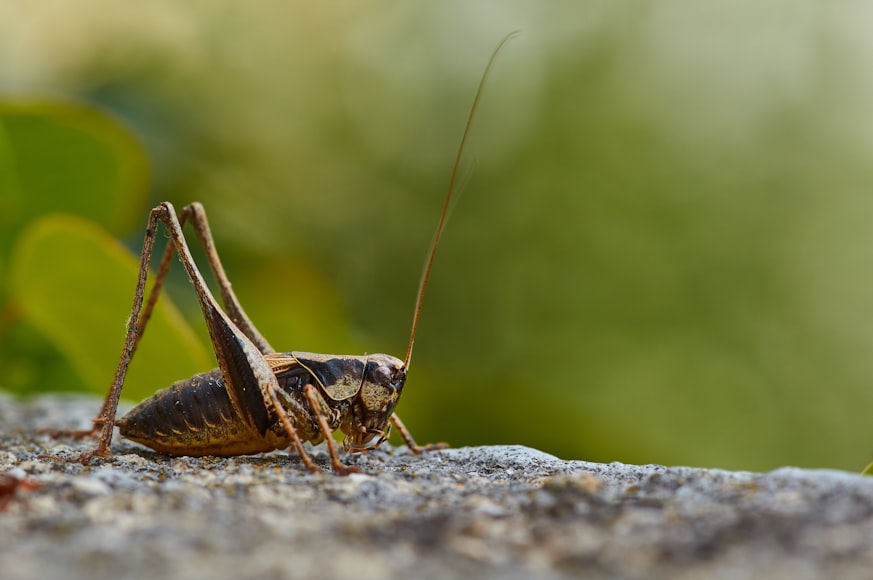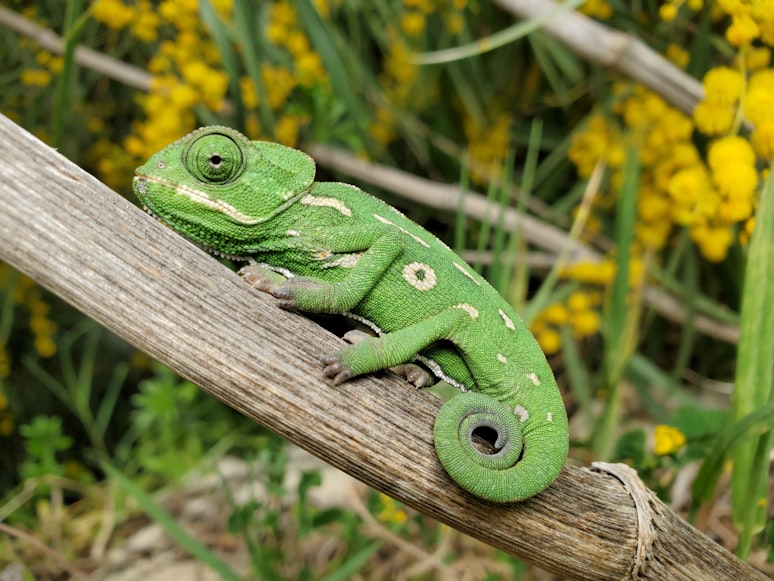How to Feed a Young Chameleon
As an Amazon Associate I earn from qualifying purchases.
What Do Baby Chameleons Eat?
A baby chameleon is the most adorable thing in the world. While you may believe they're cute, it's not easy to look after a cham. Baby chameleons are highly susceptible to stress, whether you get one from a shop, a breeder, or produce your own at home.
Because of stress resulting from incorrect care, many baby chameleons do not survive past their first month. As a result, you must understand how to properly care for them from the outset.
What do Baby Chameleons Eat?
Giving your baby chameleon the finest food is part of baby chameleon care. Chameleons are insectivores, which means they eat a lot of insects. Fruits, veggies, and plants may be included in the diet of older chameleons as well.

However, pinhead crickets and fruit flies are the greatest type of food for baby chameleons. You'll want to get bugs that are tiny enough for your chameleon's head. They should be small enough for the baby chameleon to consume and swallow. You don't want an insect that is too big; they may struggle to swallow it. In the worst-case scenario, they might choke on the bug if it gets stuck in

In general, insects are the best food for baby chameleons. Crickets are a great source of nourishment for a growing chameleon. Cricket should be their primary diet, but you may add additional insects to the mix as desired. Mealworms, flies, waxworms, moths, locusts, cockroaches, hornworms, and butterworms are some of the greatest insects to feed your baby chameleons.

It's critical to get the right food for your chameleon. If you feed them foods that are alive and healthy, they will be healthier in the long run. Those who are ill may have illnesses, which might be passed on to your baby chameleons. Pick each one separately and closely examine them if you obtained insects from a local.
Check for damage or symptoms of illness on the bugs. If you want to buy from a store, make sure they provide a money-back guarantee. Inspect each bug carefully before accepting them to verify that they are disease-free. You may return them if they aren't healthy.
What do Newborn Baby Chameleons Eat?
When they're born, chameleons are generally only hungry for a few days. This is due to the yolk sac that is connected to them when they are born. For several days, the yolk sac gives nourishment to the babies. They will mostly stay in one area and be uninterested in anything during this period.
They'll start poking around the cage after they're hungry. This is a fantastic moment to begin feeding them once you've observed them beginning to explore the cage.
Do Baby Chameleons Need Food Supplements?
Because baby chameleons develop quickly, they will require frequent vitamin and mineral supplements. Supplements are an important tool for ensuring that your chameleon gets a balanced diet. Vitamin A, D3, and E are required supplements for newborn chameleons.
What Do Baby Chameleons Eat in The Wild?
Chameleons are insectivores, which implies they primarily eat insects. These creatures may consume a wide range of insects in the wild, making it difficult to provide a complete list of what they will consume.
Regardless of where they live or species, wild baby chameleons will all consume the same sort of food. This food is typically insect, which might differ depending on the region but is frequently comprised of flies, crickets, worms, snails, grasshoppers, slugs, and even locusts.
Chameleons that live in different regions of the world eat a wide range of insects, which helps to create a well-rounded diet and ensure that the creature receives all of the nutrients it needs to survive. Depending on what they can capture and what is accessible where they live, chameleons will consume various kinds of insects.
Larger chameleons have been observed devouring a variety of tiny birds, small lizards, and even tree-climbing mice if they can get their hands on them. Veiled chameleons are another species that has been observed consuming plant material. In the wild, those veiled chameleons may supplement their diet of
How To Feed Baby Chameleons?

In the wild, chameleons consume a wide range of insects, but in captivity, they frequently do not receive all of their required nutrients. Chameleons require a diverse diet of vitamin-dusted and gut-loaded insects, such as crickets. Give your chameleon live creatures to hunt in its cage so that they may do so as they would in nature. If this approach is proving problematic for your chamaeleon, you can also offer them meals in a cup.
Step 1
Please inquire about live crickets. In captivity, crickets are the major meal supplied to chameleons. This is due to the fact that crickets are easy to maintain and produce. Chameleons also enjoy hunting for crickets in their enclosure. Live crickets can be purchased at a pet shop or from a store that specializes in selling insects. Chameleons should not be fed crickets straight from the pet shop since these insects will most likely not be fed. Gut loading and dusting are required for each species.
The length of the cricket should not exceed the width of your chameleon's head. Every day, feed your baby chameleons. Chameleons up to three months old should be fed as many tiny crickets as they can consume. You can begin feeding your chameleon every other day as early as six to twelve months old, depending on the species. The average adult chameleon consumes between five and twelve crickets each meal.
Step 2
Other insects might be added to the chameleon's diet. While crickets will make up the majority of your chameleon's food, you may add other invertebrates. These creatures will be acquired, bred, and gut-loaded in the same way as crickets. Other insects, on the other hand, should be used as special snacks for your chameleon to balance out their cricket diet. This includes earthworms and other invertebrates that have previously been discussed.
Step 3
Fill the crickets with earthworms. To improve the nutrition value of chameleons, feed them special meals such as gut loads. Be sure to offer the baby chameleons with high calcium, nutritious food a few hours before feeding them for full gut loading. Leafy greens, sweet potatoes, carrots, oranges, mangoes, broccoli, and apples are all excellent options.
Step 4
Vitamin supplements can be used to repel insects. Your chameleon must get the right nutrients. You may improve your chameleons' vitamin and calcium intake by dusting the bugs with a special mineral and vitamin powder. Sprinkle your crickets with a mineral and vitamin powder that is made just for lizards and can be found in most pet shops. Sprinkle the dust over the crickets after wetting them with water. Do this right before feeding the crickets.
You'll need to dust young chameleons' food with calcium supplements twice or three times a week, depending on the age. Once every two weeks, use a multivitamin powder. Only mature chameleons require their diet to be dusted with calcium once a week.
Vitamin A insufficiency is common among chameleons. While feeding insects with foods high in Vitamin A might be enough, you may also give them a vitamin A supplement dust. Twice as much calcium as phosphorus is included in superior calcium dust.
What Are The Natural Predators of Baby Chameleons?
Chameleons, the most famous reptiles for changing colors and blending into backgrounds, are at the bottom of the food chain and have evolved several strategies to do so. It has eyes that can move independently, allowing it to look in different directions at the same time. When a snake or bird is on their trail, they are also able to run fast. Man, on the other hand, is the chameleon's greatest adversary.
Snakes
In the chameleon's native Africa, snakes will pursue it into the trees. Climbing snakes such as the Boomslang and Vine are to blame. Because boomslangs spend the majority of their time in trees, they pose a risk to chameleons. Chameleon eggs may also be stolen by snakes.
Birds
Birds will attempt to capture chameleons from tree branches. They are not as good at it as snakes because the chameleon's camouflage makes them difficult to detect through the foliage. Chameleons are easy to keep, and they can subsist on a wide range of diets. However, coucals, shrikes, and hornbills are the most dangerous predators. Chameleon eggs may also be taken by birds in much the same way as snakes.
Monkeys
Monkeys have been observed eating chameleons, but this is not common. Chameleons and monkeys do not cohabit in the same region frequently, and even when they do there are more accessible food sources for primates.
How To Protect Baby Chameleons From Predators?
Chameleons rely on their natural state color, a greenish-brown, to blend in. They do use camouflage, however, which is the ability to merge into their surroundings and hide from predators such as snakes and birds. In general, they rely on their natural hue of greenish-brown to conceal themselves. They prefer to keep quiet and hidden if they are frightened, but they do have ways of defending themselves if required. They can flatten out their bodies to make them seem larger, and they can bite and stomp with their feet.
Brown chameleons live on the ground and green chameleons in trees help them blend in with their environment. These animals can hide from their prey by doing so. These animals sit still and wait for their dinner to come to them before attacking with their long sticky tongues. Chameleons have sticky mitten-like feet that allow them to firmly grasp the ground or a limb. Chameleons have distinct eyes that enable them to see two things at the same time. This talent enables chameleons to rapidly detect potential predators and prey with their unique eyes.
Are Baby Chameleons Healthy To Eat?
Chameleons are not found to be poisonous. There is no record of a chameleon-based species being poisonous when eaten, nor is there evidence that any can spit or bite to inject poison.
Chameleons are a protected species, and it is prohibited to kill them. Never eat a chameleon. If your pet has eaten part of a chameleon, there is usually no harm or responsibility involved. Reptiles are known carriers of salmonella bacteria, therefore you should visit the veterinarian simply to be safe.
Amazon and the Amazon logo are trademarks of Amazon.com, Inc, or its affiliates.
Source: https://feedingnature.com/what-do-baby-chameleons-eat/
0 Response to "How to Feed a Young Chameleon"
Post a Comment